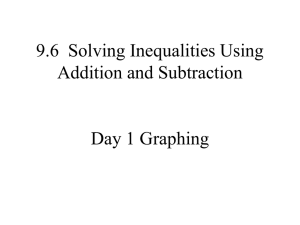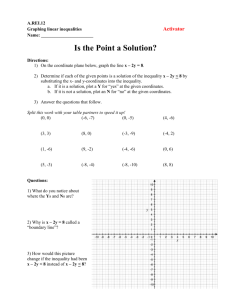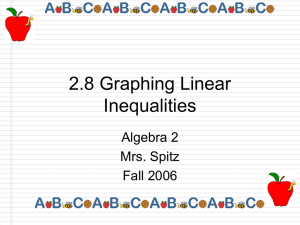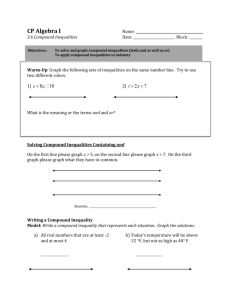Solving and Graphing Inequalities
advertisement
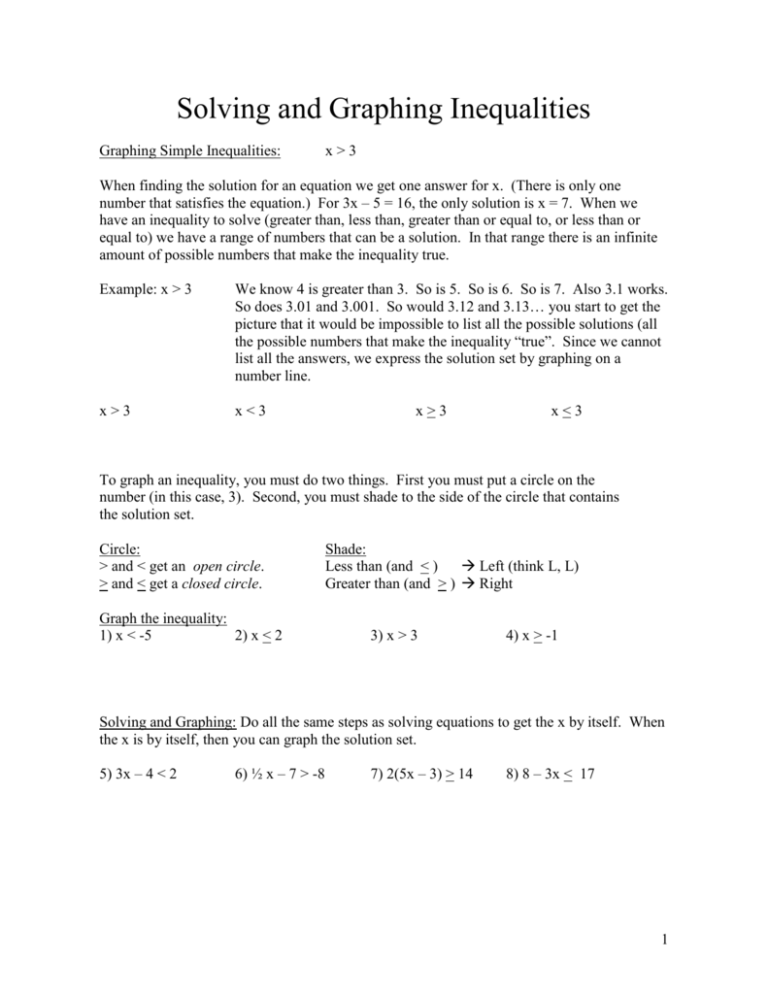
Solving and Graphing Inequalities Graphing Simple Inequalities: x>3 When finding the solution for an equation we get one answer for x. (There is only one number that satisfies the equation.) For 3x – 5 = 16, the only solution is x = 7. When we have an inequality to solve (greater than, less than, greater than or equal to, or less than or equal to) we have a range of numbers that can be a solution. In that range there is an infinite amount of possible numbers that make the inequality true. Example: x > 3 We know 4 is greater than 3. So is 5. So is 6. So is 7. Also 3.1 works. So does 3.01 and 3.001. So would 3.12 and 3.13… you start to get the picture that it would be impossible to list all the possible solutions (all the possible numbers that make the inequality “true”. Since we cannot list all the answers, we express the solution set by graphing on a number line. x>3 x<3 x>3 x<3 To graph an inequality, you must do two things. First you must put a circle on the number (in this case, 3). Second, you must shade to the side of the circle that contains the solution set. Circle: > and < get an open circle. > and < get a closed circle. Graph the inequality: 1) x < -5 2) x < 2 Shade: Less than (and < ) Left (think L, L) Greater than (and > ) Right 3) x > 3 4) x > -1 Solving and Graphing: Do all the same steps as solving equations to get the x by itself. When the x is by itself, then you can graph the solution set. 5) 3x – 4 < 2 6) ½ x – 7 > -8 7) 2(5x – 3) > 14 8) 8 – 3x < 17 1 THE ONE DIFFERENCE BETWEEN SOVING EQUATIONS AND INEQUALITIES When you multiply or divide on both sides by a negative number, you must turn the inequality around. 8 – 3x < 17 -8 -8 - 3x < 9 -3 -3 * Dividing both sides by -3, you must turn the inequality around. It changes from < to >. x > -3 Solve and Graph: 9) 12 – ⅔ x > 6 10) 12x – 6 > 14x – 2 11) 3(5x + 7) > 81 12) 11 > 4x + 31 13) 7(5 – 8x) > 147 14) 3(4x + 1) < -27 2 Solve and Graph: 1) 3/5 x + 9 < 12 2) 4(2-3x) < 32 3) -21 < 7x – 144 4) 5x – 2 < 7x – 8 5) 11x – 5 > 15x + 3 6) 8x + 3 > 12x + 13 7) 24 – (5/6)x < 34 8) 8(11-2x) < 24 9) 10 > 8 - ⅔ x 10) 5(3x + 1) < -70 11) 15 - ⅝ x > 10 12) 24x – 32 < 8(5x – 12) 3 Quiz 6 Review: Simple Inequalities 1) 12x – 17 > 19 2) 41 – ¾ x < 53 3) 14x - 2 > 20x + 10 4) 8(5x – 4) – 6(3x + 5) < -7 5) 6(4x -2) > 5(7x + 2) 6) 16 < 5x – 4 4 7) 6(6x – 3) + 4(7 – 12x) > 28 8) -24 < 26 - ⅝ x 9) 8(7x + 5) > 5(4x + 8) 10) 4(7x +3) – (16x – 13) > 17 11) 7(6x – 4) < 4(3x – 7) 12) (15x – 8) – (19x + 8) < -14 5 Compound Inequalities Graphing Compound Inequalities: Compound inequalities are problems that have more than one inequality that have to be graphed together. There are two different types we need to understand. AND ( ) problems and OR ( ) problems. When graphing a compound in equality, graph each inequality separately and then follow the rules for AND and OR problems. AND: both must be true (for the number to be a part of the solution set, it must satisfy both parts of the compound inequality). “Graph both and keep the INTERSECTION.” OR: one must be true. (If the number satisfies either part of the compound inequality, or both parts, it is part of the solution set). “Graph both and leave it alone.” Example: x < 2 and x > -3 x < -3 or x > 4 (x < 2 and x < -3 can also be written as – 3 < x < 2) Do Now: 1) 3x 5 11 5 – ½ x < 1 2) 12 – 4x > 20 5x – 7 > 18 6 3) 12x – 17 > -17 12 - ⅝ x > 17 4) -12 < 7x + 2 < 23 5) 3x 5 17 2 x 5 6 6) 3x – 4 > -7 or 4 – 11x < -51 7 Quiz 7 Review: Compound Inequalities 1) 2x – 5 > 3 U 11 – 3x > -2 2) 2 < 5x + 7 < 32 3) 10 – 2x > 3 ∩ 7– ¼ x < 7 4) 6(3x – 1) < -96 U 2 < 7x – 5 5) 16 – 5x < 31 ∩ 8x – 7 > 1 6) 11- ½ x > 9 U 8x + 6 > -6 8 7) 26 – 3x < 17 ∩ 9x + 7 < -29 8) -20 < 9x – 2 < -20 9) ½ x + 11 > 13 ∩ 15 – 4x > 23 10) 11 - ⅗ x < 8 U 11x + 6 > 6 11)15 – 9x > 42 ∩ 7x + 2 < 16 12) 13 - ⅔ x > 15 ∩ 8x - 11 > -35 9





